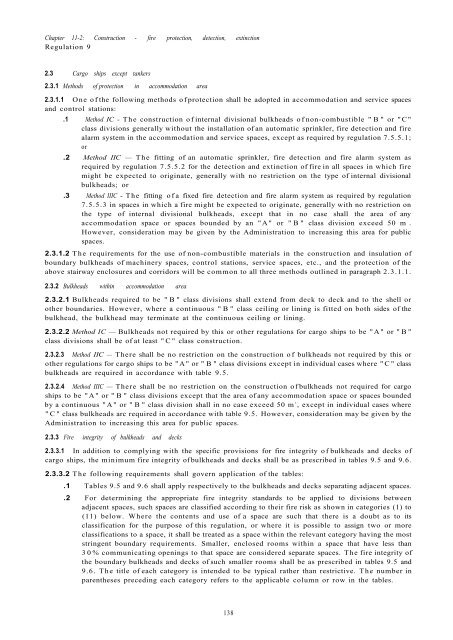Solas Consolidated Edition 2009.pdf
Solas Consolidated Edition 2009 for maritime
Solas Consolidated Edition 2009 for maritime
You also want an ePaper? Increase the reach of your titles
YUMPU automatically turns print PDFs into web optimized ePapers that Google loves.
Chapter 11-2: Construction - fire protection, detection, extinction<br />
Regulation 9<br />
2.3 Cargo ships except tankers<br />
2.3.1 Methods of protection in accommodation area<br />
2.3.1.1 One of the following methods of protection shall be adopted in accommodation and service spaces<br />
and control stations:<br />
.1 Method IC - The construction of internal divisional bulkheads of non-combustible "B" or "C"<br />
class divisions generally without the installation of an automatic sprinkler, fire detection and fire<br />
alarm system in the accommodation and service spaces, except as required by regulation 7.5.5.1;<br />
or<br />
.2 Method IIC — The fitting of an automatic sprinkler, fire detection and fire alarm system as<br />
required by regulation 7.5.5.2 for the detection and extinction of fire in all spaces in which fire<br />
might be expected to originate, generally with no restriction on the type of internal divisional<br />
bulkheads; or<br />
.3 Method IIIC - The fitting of a fixed fire detection and fire alarm system as required by regulation<br />
7.5.5.3 in spaces in which a fire might be expected to originate, generally with no restriction on<br />
the type of internal divisional bulkheads, except that in no case shall the area of any<br />
accommodation space or spaces bounded by an "A" or "B" class division exceed 50 m .<br />
However, consideration may be given by the Administration to increasing this area for public<br />
spaces.<br />
2.3.1.2 The requirements for the use of non-combustible materials in the construction and insulation of<br />
boundary bulkheads of machinery spaces, control stations, service spaces, etc., and the protection of the<br />
above stairway enclosures and corridors will be common to all three methods outlined in paragraph 2.3.1.1.<br />
2.3.2 Bulkheads within accommodation area<br />
2.3.2.1 Bulkheads required to be "B" class divisions shall extend from deck to deck and to the shell or<br />
other boundaries. However, where a continuous "B" class ceiling or lining is fitted on both sides of the<br />
bulkhead, the bulkhead may terminate at the continuous ceiling or lining.<br />
2.3.2.2 Method IC — Bulkheads not required by this or other regulations for cargo ships to be "A" or "B"<br />
class divisions shall be of at least "C" class construction.<br />
2.3.2.3 Method IIC — There shall be no restriction on the construction of bulkheads not required by this or<br />
other regulations for cargo ships to be "A" or "B" class divisions except in individual cases where "C" class<br />
bulkheads are required in accordance with table 9.5.<br />
2.3.2.4 Method IIIC — There shall be no restriction on the construction of bulkheads not required for cargo<br />
ships to be "A" or "B" class divisions except that the area of any accommodation space or spaces bounded<br />
by a continuous "A" or "B" class division shall in no case exceed 50 m 2 , except in individual cases where<br />
"C" class bulkheads arc required in accordance with table 9.5. However, consideration may be given by the<br />
Administration to increasing this area for public spaces.<br />
2.3.3 Fire integrity of bulkheads and decks<br />
2.3.3.1 In addition to complying with the specific provisions for fire integrity of bulkheads and decks of<br />
cargo ships, the minimum fire integrity of bulkheads and decks shall be as prescribed in tables 9.5 and 9.6.<br />
2.3.3.2 The following requirements shall govern application of the tables:<br />
.1 Tables 9.5 and 9.6 shall apply respectively to the bulkheads and decks separating adjacent spaces.<br />
.2 For determining the appropriate fire integrity standards to be applied to divisions between<br />
adjacent spaces, such spaces are classified according to their fire risk as shown in categories (1) to<br />
(11) below. Where the contents and use of a space are such that there is a doubt as to its<br />
classification for the purpose of this regulation, or where it is possible to assign two or more<br />
classifications to a space, it shall be treated as a space within the relevant category having the most<br />
stringent boundary requirements. Smaller, enclosed rooms within a space that have less than<br />
30% communicating openings to that space are considered separate spaces. The fire integrity of<br />
the boundary bulkheads and decks of such smaller rooms shall be as prescribed in tables 9.5 and<br />
9.6. The title of each category is intended to be typical rather than restrictive. The number in<br />
parentheses preceding each category refers to the applicable column or row in the tables.<br />
138


